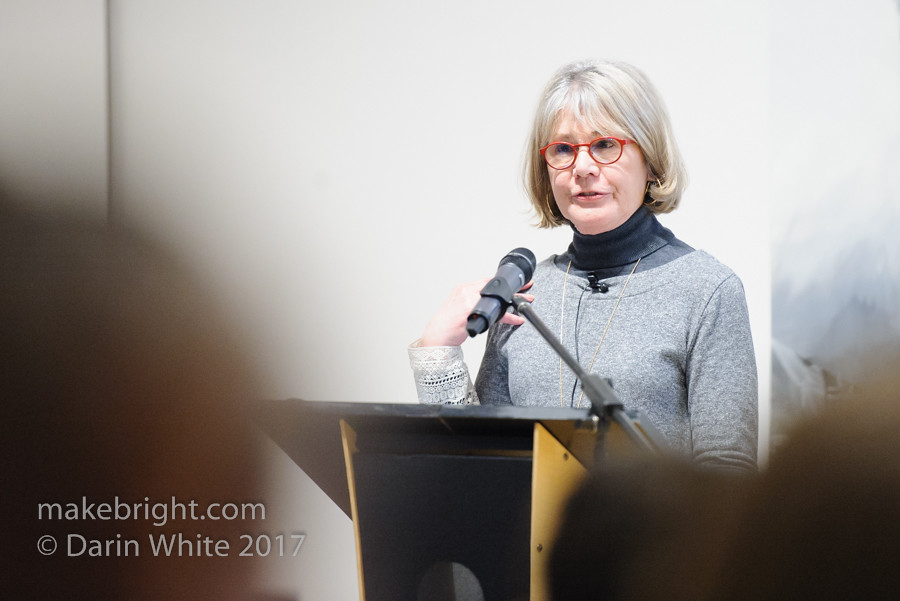by Hilary Dow
 Suzy Lake discussing her work at the Art Gallery of Guelph, 2017. Image (c) Darin White.
Suzy Lake discussing her work at the Art Gallery of Guelph, 2017. Image (c) Darin White.
(http://makebright.com/2017/01/kick-ass-photog-suzy-lake-at-art-gallery-o...)
On February 22nd, I had the opportunity to interview Suzy Lake in preparation for a research essay. We conducted the interview over a cup of coffee in her studio. It was rather informal, but an excellent conversation that revealed aspects of her work and historical details that I never knew about before.
Q: In the ‘60s and ‘70s did you identify with a certain movement of feminism (cultural feminism or radical feminism?) Was your understanding and approach to feminism realized as a result of social movements or personal experiences?
SL: In the ‘60s and the ‘70s, feminism was different for different women at the time. The ‘60s was a generation where women were instructed on how to be a wife and a mother. It was an affluent time for feminism and there was the “illusion” that doors were open for women. In the earlier ‘60s (pre-1966), we felt that we were feminists. The problem was that young women at the time didn’t see what older women saw about the glass ceiling. Some early radical feminists, in the art world, were anti-men and I didn’t associate with that. I came to feminism through my interest in the larger umbrella of social change that was happening in of the ‘60s. I was involved in community groups and was active in social change movements. For me, the institution of patriarchy was realized through a combination of social movements and personal experiences.
Q: Were you influenced by any feminist or political writers?
SL: I did read Betty Friedan in High School, and I was exposed to Gloria Steinem through rallies and civil rights meetings. Writers that influenced my sociopolitical thought were Malcolm X and Kurt Vonnegut. Female activists influenced me just as much as writers did(or more).
Q: What artists in Canada were dealing with feminist concerns when you came to prominence in the ‘70s and which artists influenced you?
SL: Artists that inspired me were the ones that expanded beyond the tropes in their mediums, such as Symone Forti and Evonne Remer. These artists were looking at feminist themes, even if they didn’t identify as feminists at the time. Their works also tackled issues of identity that didn’t exclude men. Adrian Piper was another artist that covered issues that I felt were particularly important. An artist in Canada that was looking at similar issues as myself Martha Wilson (who was then based in Halifax in the '70s).
Q: How does the “male gaze” influence your work?
SL: Feminist elements in my early works such as On Stage were removed from critics’ writings. Feminist art was not acknowledged at the time. My Transformations series was admired on a conceptual level, and the works that were celebrated were successful because they fit within conceptual art. In On Stage, I was trying to figure out how to look at issues of identity, and I made the work three times because it was always seen through the male gaze. It was deemed superficial, and I was being judged according to what I (as a woman) looked like, rather than what the work was actually about. I never understood why my work was labeled as “women’s work”, while works by men of the time (that dealt with sexual themes) were not called “man’s work”.
I could not escape the male gaze. When my work ImPositions exhibited at the AGO, a review was published containing the headline of something along the lines of, “Why is a pretty young girl wrapped up like a Turkey?”. The work was dealing with the issues of victimization and power struggle, but because I am a woman the work was immediately associated with bondage.
Q: Did mass-media that communicated images about beauty impact your work from the 70s?
Yes. In Miss Chatelaine, I took cut-outs of hairstyles from beauty magazines from the period in order to mimic ideas about beauty and images of women.
Q: What about female sexuality; how does this fit in your work? Does the sexualized objectification of women play in your work and is this related to the issue of female beauty?
SL: Throughout my career, I intentionally avoided art using the nude body in my work, and instead I choose to dress in androgynous clothing to avoid and avert the male gaze. I felt that I had to do this in order to comment on issues of identity; revealing clothing always seemed to invite the male gaze and I didn’t want that. In my series Peonies and Lido, I am particularly androgynous.
Q: Do you think that your recent work that deals with aging is a critique of female beauty or a feminist issue, or is it speaking to something else?
SL: My later work looks at aging and consumer culture. We live in a culture where 40 is the new 50; a youth-obsessed culture.
Beauty at a Proper Distance came out of a period of anger, over anger about ageism, and the lack of respect for aging women. In the work, I use signs of aging and make fun of fears of aging by inverting its meaning. From far away, the photos look like glamor shots but up-close you see facial hair, pores, etc. so it is a form of ironic humour.
Q: In your opinion, what is the most dominant “feminist” theme in your work?
SL: The dominant feminist theme in my work is the fact is it presents a metaphor that every woman can enter into. What was said about me at the AGO show opening revealed this to me. So many different women (artists, writers) came out and were there and celebrated that moment. It was an amazing night.
